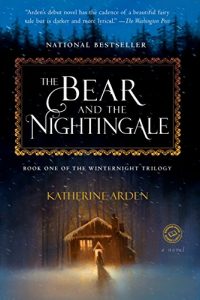Katherine Arden’s The Bear and the Nightingale is set in old Russia, long before there was a Soviet Union and even before a Russia existed. There was only the Rus people and they lived scattered, outposts of people in an otherwise hostile world. A world in which the creatures of fairy tales are real, though very few people can see them directly.
The Bear and the Nightingale is set in old Russia, long before there was a Soviet Union and even before a Russia existed. There was only the Rus people and they lived scattered, outposts of people in an otherwise hostile world. A world in which the creatures of fairy tales are real, though very few people can see them directly.
Vasya, the daughter of Pyotr, the leader of one of the furthest settlements, is one such person. She can see these creatures everyone since, in old Rus lore, they literally exist everywhere. Every building has such a creature that tends it — the house, the bathhouse, the stables. Vasya, being one of the very few that can see them and thus interact with them, and unburdened by the harsh interpretation that Christianity imposes about them, becomes their friend and learns from them. They teach her the impossible, such as how to talk with animals, and soon she is riding horses bare-back with a skill that rivals the best warriors of the village.
The plot involves some powerful beings from Russian folklore and Vasya’s role in protecting her family from them. Saying more would give it away. However, throughout the story, Vasya is the strongest character, the one that stands up for what is right even if it means being on the wrong end of scorn and, often, punishment. Her strength is juxtaposed with the weaknesses of her step-mother, who can also see the so-called ‘demons.’ In the end, it is Vasya’s willingness to accept the reality around her and her ability to see beyond the social constructs that dictate the lives of everyone else that enable her to be such a strong protagonist. She doesn’t constrain her beliefs and actions on what is right or wrong by social norms, she simply does what she thinks is right.
Vasya’s world is filled with the supernatural, a world that even her closest relatives are almost completely ignorant of. They have their superstitions and such, but they don’t directly interact with the supernatural. Arden does a great job of bringing the supernatural to life in this story as well as juxtaposing Vasya’s existence in it, on the one hand deeply immersed in a world of fairies and on the other the mundane world of humans. Vasya lives in both worlds and, through her initial innocence, is able to do so without any contradiction. To her, both are part of the natural world. For her, the world of people, and the people themselves, are often more frightening than the supernatural creatures she encounters.
Vasya also lives in a time where women were expected to do one of two things: become a wife and mother or join a convent. “I was born for a cage, after all: convent or house, what else is there?” She sees much more in the real world and longs for a freedom that simply isn’t an option for women of her time.
The supernatural world is handled deftly by Arden. While ever-present, it isn’t overwhelming either. That is, it adds to the story rather than distract from it. Arden also develops an interesting view on magic. One character tells Vasya “Nothing changes, Vasya. Things are, or they are not. Magic is forgetting that something ever was other than as you willed it.” Magic is looking beyond the possibilities the world imposes on us, whether expectations of what things or of what people are. Either can become more than what they were originally intended if you can look beyond that original purpose.
This is the first of three books that follow the story of Vasya. In this one, we mostly follow her life as a child and her growing into her role in the world, both human and supernatural. It seems like it will be a challenge to retain the innocence that drives a lot of Vasya’s character in this chapter of the story. However, that also means that Vasya is destined for even greater things. We shall see.